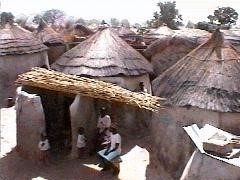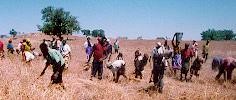Resource 5: The Namalteng Integrated Development Programme (NIDEP)
![]() Teacher resource for planning or adapting to use with pupils
Teacher resource for planning or adapting to use with pupils
The area to the southeast of Bolgatanga, the regional capital of the Upper Eastern Region of Ghana, is the home of the Tallensi people. The Tallensi Traditional Area is mostly open savanna, characterised by a large tree every two or three hundred metres with the land almost totally in use for the subsistence farming of grains. The Tallensi people live in ‘compound houses’ dotted around the savanna. These are a collection of round, straw thatched, mud huts with their outer walls joined together to form an enclosing compound.

Each nuclear family in the compound house will farm about one or two acres, typically planted with cereals. The farming (wet) season runs for about four months of the year. During this period they will, hopefully, grow enough to get two or three large sacks of grain. One will be sold for typically ¢50,000 and the rest eaten during the remaining eight months of the year when it is too dry to grow anything.
During the dry season, they have a pretty easy time, labour wise, with only the animals (mostly goats and chickens) to take care of and occasional house maintenance to occupy them.
This four months on/eight months off sounds pretty idyllic, but as the year continues they enter what is called the ‘lean season’, when the food stores from the last harvest run low and they have to go down to one meal a day or less.
The Namalteng Integrated Development Programme (NIDEP) is a local non-governmental organisation, founded and run by Tallensi, which works to improve the situation of the people of the area. The programme director of NIDEP is Pius Puzotkpet Tushyin (shown below) who is also chief of the small village of Gbeogo, southeast of Bolgatanga. NIDEP is run by a committee of ten or so, including a couple of local government employees, all of whom work as volunteers.
NIDEP concentrates on two development areas: tree planting and education.
NIDEP tree planting projects
NIDEP has tree planting projects at many villages in the area. NIDEP has a ‘formula’, which it uses in starting these projects. The formula is, briefly:
- one-year education programme on the benefits of trees;
- getting the community to donate land, typically 2 hectares (5 acres);
- motivating the community to work voluntarily on the plantation;
- providing seedlings and tools.
The Tallensi have no tradition of planting trees. This is due in part to a lack of historical need, as the area was forested a couple of generations ago and forests renewed naturally, obviating the need to plant trees. There is also much superstition and taboo against the idea of planting trees, as local beliefs state that trees represent spirits and it would be bad to interfere with the natural course of the spiritual world.
NIDEP tries to overcome these beliefs and general environmental ignorance by constantly visiting and giving educational presentations to targeted villages.
Once the villagers are converted, the next step is to get land allocated. This is usually given by the chief of the village, or occasionally by an elderly farmer, on a ‘community use’ basis. The community is then organised to create and maintain the plantation. The work of planting and taking care of the trees is almost always done by the women, who work voluntarily. NIDEP will try, if money is available, to provide tools for the planting process, and it organises the provision of seedlings.

After planting, NIDEP provides no further assistance, other than advice. The community will water, weed, prune, keep off animals, and otherwise take care of the trees on their own. The entire project is done on a community-works-community-benefits basis. The community provides the land and the workers, and the benefits of harvesting, or profits for cash crops, are shared by the community.
NIDEP promotes the planting of ‘economic’ trees, i.e. trees that will help the community economically as well as environmentally. Most of the plantations I saw were either of Cassiaw albesia or teak. NIDEP is also promoting the planting of cashew, mango, guava, papaya (pawpaw), dowa-dowa and shea.
Resource 4: Questions concerning use of the land



